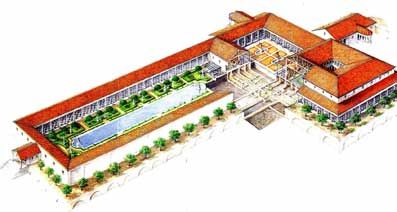The Villa of the Papyri is a private house in the ancient Roman city of Herculaneum The villa was owned by Julius Caesar’s father-in-law, Lucius Calpurnius Piso Caesoninus. In AD 79, the eruption of Vesuvius covered all of Herculaneum with some 30 m of volcanic ash. Its name derives from the discovery of a library in the house containing 1,785 carbonized papyrus scrolls, the “Herculaneum papyri”, more than 1,800 papyri found in Herculaneum in the 18th century, carbonized by the eruption.
The papyri, unrolled and read, after various methods of manipulation, containing a number of Greek philosophical texts, come from a single personal library associated with the Epicurean philosopher and poet Philodemus.
The discovery of Villa dei Papiri in 1750 increased attention towards Herculaneum’s excavations. In 1780 the works were interrupted and concentrated in Pompeii mainly because of easier type of excavations due to different volcanic burial phenomena. The technique of building underground passages and wells was interrupted in 1828, when open-air excavations were permitted and carried out until 1875. After a long interruption, the works started again in 1927 with Amedeo Mauri, who directed them until 1958; in 1942 almost the whole area that is part of what today represents the archaeological area had already been brought to light. Between 1960 and 1969 more works were carried out in the Northern area of Insula VI and along the Decumano maggiore, and in the last two decades of the last century the beach located in the Southern point of the archaeological area was explored.
The villa’s front stretched for more than 250 meters, parallel to the coastline of what is now called the Gulf of Naples. It was also surrounded by a garden closed off by porticoes, but with an ample stretch of vegetable gardens, vineyards and woods down to a small harbour.
The villa remains faithful in its general layout to the fundamental structural and architectural scheme of the suburban villa in the country around Pompeii. The atrium worked as an entrance hall and a means of communication with the various parts of the house. The entrance opened with a columned portico on the sea side. Around the atrium impluvium were 11 fountain statues depicting Satyrs pouring water from a pitcher and Amorini pouring water from the mouth of a dolphin. Other statues and busts were found in the corners around the atrium walls.
The first peristyle had 10 columns on each side and a swimming bath in the center. In this enclosure were found the bronze herma of Doryphorus, a replica of Polykleitos’ athlete, and the herma of an Amazon made by Apollonios son of Archias of Athens. The large second peristyle could be reached by passing through a large tablinum in which, under a propylaeum, was the archaic statue of Athena Promachos.
The real living and reception quarters were grouped around the porticoes and terraces, giving occupants ample sunlight and a view of the countryside and sea. In the living quarters the library were brought to light of rolled and carbonized papyri placed inside wooden capsae, some of them on ordinary wooden shelves and around the walls and some on the two sides of a set of shelves in the middle of the room.
The gardens included a gallery of busts, hermae and small marble and bronze statues. These were laid out between columns amid the open part of the garden and on the edges of the large swimming bath.

A copy of the Villa of Papyri in Malibu
This museum building was constructed in the early 1970s by the architectural firm of Langdon and Wilson. Architectural consultant Norman Neuerburg and Getty’s curator of antiquities Jiri Frel worked closely with J. Paul Getty to develop the interior and exterior details. Since the Villa of the Papyri was buried by the eruption and much of it remains unexcavated, Neuerburg based many of the villa’s architectural and landscaping details on elements from other ancient Roman houses in the towns of Pompeii, Herculaneum, and Stabiae.
With the move of the Museum to the Getty Center, the “Getty Villa” as it is now called, was renovated; it reopened on January 28, 2006.



Thank you for the information on theses new techniques to investigate very old and important historic documents.